B628 Leadership: Analyzing the Born vs. Made Debate at AOU Fall 2017
VerifiedAdded on 2023/06/12
|9
|2867
|58
Essay
AI Summary
This essay delves into the concept of leadership, addressing the ongoing debate of whether leaders are born or made. It references the B628 course material from Arab Open University, particularly Chapter 7, and an attached article to analyze the author's perspective on leadership from both theoretical and personal standpoints. The essay explores the characteristics and skills associated with both types of leaders—those with innate abilities and those who acquire them through learning and experience. It further discusses how leadership skills can be developed through observation, education, and practice, emphasizing the importance of continuous learning and adaptation for all leaders. The essay concludes by acknowledging the differences between born and made leaders, highlighting the strengths and contributions of each type within organizations.
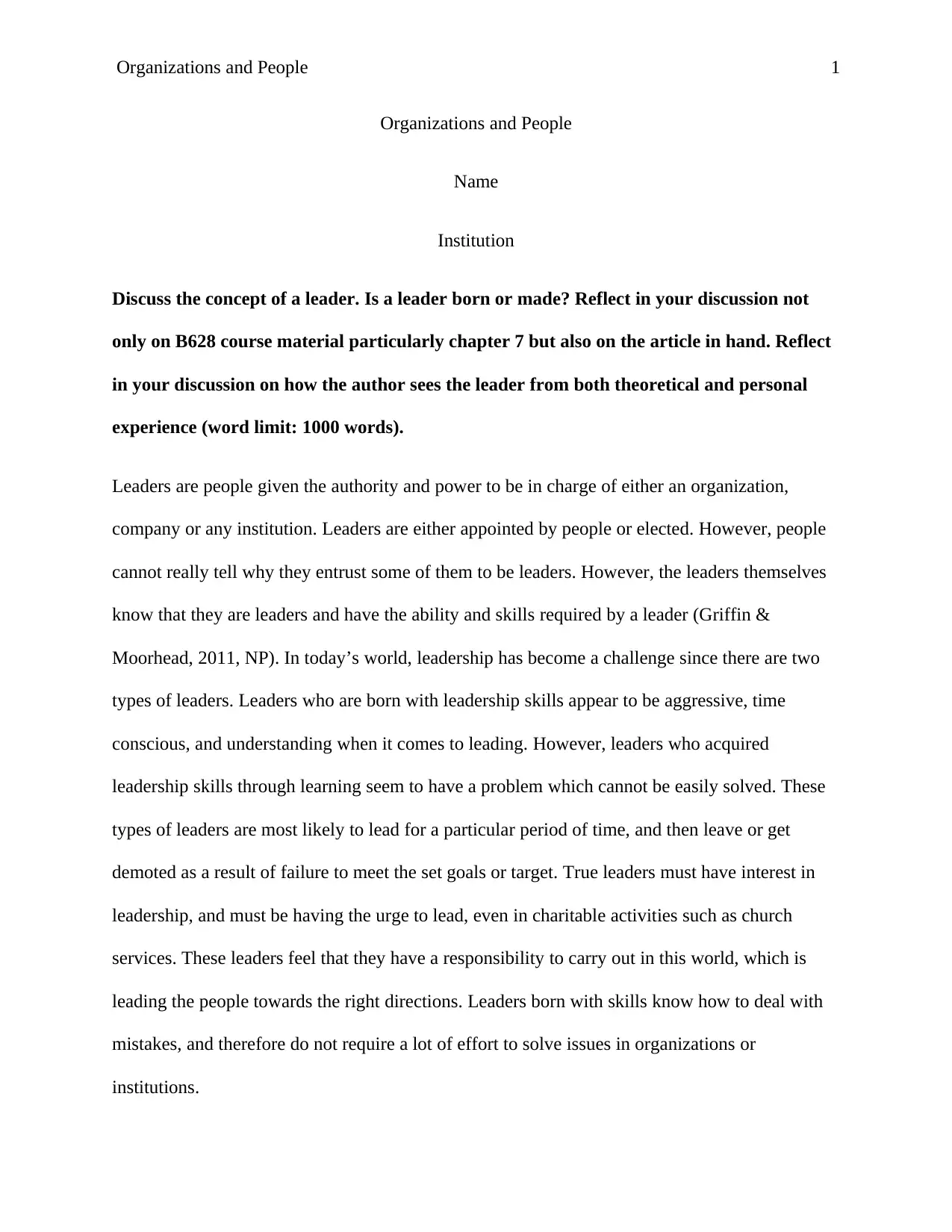
Organizations and People 1
Organizations and People
Name
Institution
Discuss the concept of a leader. Is a leader born or made? Reflect in your discussion not
only on B628 course material particularly chapter 7 but also on the article in hand. Reflect
in your discussion on how the author sees the leader from both theoretical and personal
experience (word limit: 1000 words).
Leaders are people given the authority and power to be in charge of either an organization,
company or any institution. Leaders are either appointed by people or elected. However, people
cannot really tell why they entrust some of them to be leaders. However, the leaders themselves
know that they are leaders and have the ability and skills required by a leader (Griffin &
Moorhead, 2011, NP). In today’s world, leadership has become a challenge since there are two
types of leaders. Leaders who are born with leadership skills appear to be aggressive, time
conscious, and understanding when it comes to leading. However, leaders who acquired
leadership skills through learning seem to have a problem which cannot be easily solved. These
types of leaders are most likely to lead for a particular period of time, and then leave or get
demoted as a result of failure to meet the set goals or target. True leaders must have interest in
leadership, and must be having the urge to lead, even in charitable activities such as church
services. These leaders feel that they have a responsibility to carry out in this world, which is
leading the people towards the right directions. Leaders born with skills know how to deal with
mistakes, and therefore do not require a lot of effort to solve issues in organizations or
institutions.
Organizations and People
Name
Institution
Discuss the concept of a leader. Is a leader born or made? Reflect in your discussion not
only on B628 course material particularly chapter 7 but also on the article in hand. Reflect
in your discussion on how the author sees the leader from both theoretical and personal
experience (word limit: 1000 words).
Leaders are people given the authority and power to be in charge of either an organization,
company or any institution. Leaders are either appointed by people or elected. However, people
cannot really tell why they entrust some of them to be leaders. However, the leaders themselves
know that they are leaders and have the ability and skills required by a leader (Griffin &
Moorhead, 2011, NP). In today’s world, leadership has become a challenge since there are two
types of leaders. Leaders who are born with leadership skills appear to be aggressive, time
conscious, and understanding when it comes to leading. However, leaders who acquired
leadership skills through learning seem to have a problem which cannot be easily solved. These
types of leaders are most likely to lead for a particular period of time, and then leave or get
demoted as a result of failure to meet the set goals or target. True leaders must have interest in
leadership, and must be having the urge to lead, even in charitable activities such as church
services. These leaders feel that they have a responsibility to carry out in this world, which is
leading the people towards the right directions. Leaders born with skills know how to deal with
mistakes, and therefore do not require a lot of effort to solve issues in organizations or
institutions.
Paraphrase This Document
Need a fresh take? Get an instant paraphrase of this document with our AI Paraphraser
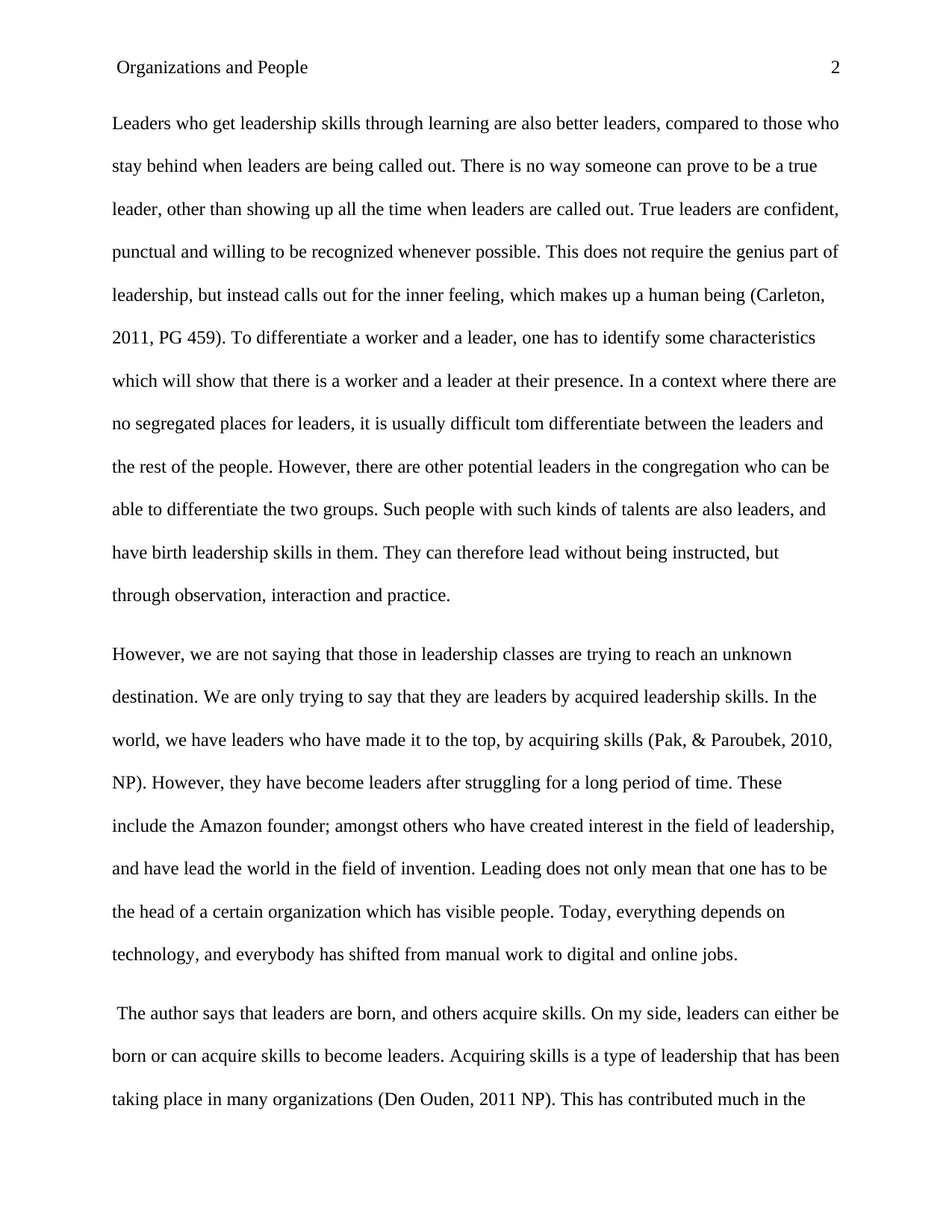
Organizations and People 2
Leaders who get leadership skills through learning are also better leaders, compared to those who
stay behind when leaders are being called out. There is no way someone can prove to be a true
leader, other than showing up all the time when leaders are called out. True leaders are confident,
punctual and willing to be recognized whenever possible. This does not require the genius part of
leadership, but instead calls out for the inner feeling, which makes up a human being (Carleton,
2011, PG 459). To differentiate a worker and a leader, one has to identify some characteristics
which will show that there is a worker and a leader at their presence. In a context where there are
no segregated places for leaders, it is usually difficult tom differentiate between the leaders and
the rest of the people. However, there are other potential leaders in the congregation who can be
able to differentiate the two groups. Such people with such kinds of talents are also leaders, and
have birth leadership skills in them. They can therefore lead without being instructed, but
through observation, interaction and practice.
However, we are not saying that those in leadership classes are trying to reach an unknown
destination. We are only trying to say that they are leaders by acquired leadership skills. In the
world, we have leaders who have made it to the top, by acquiring skills (Pak, & Paroubek, 2010,
NP). However, they have become leaders after struggling for a long period of time. These
include the Amazon founder; amongst others who have created interest in the field of leadership,
and have lead the world in the field of invention. Leading does not only mean that one has to be
the head of a certain organization which has visible people. Today, everything depends on
technology, and everybody has shifted from manual work to digital and online jobs.
The author says that leaders are born, and others acquire skills. On my side, leaders can either be
born or can acquire skills to become leaders. Acquiring skills is a type of leadership that has been
taking place in many organizations (Den Ouden, 2011 NP). This has contributed much in the
Leaders who get leadership skills through learning are also better leaders, compared to those who
stay behind when leaders are being called out. There is no way someone can prove to be a true
leader, other than showing up all the time when leaders are called out. True leaders are confident,
punctual and willing to be recognized whenever possible. This does not require the genius part of
leadership, but instead calls out for the inner feeling, which makes up a human being (Carleton,
2011, PG 459). To differentiate a worker and a leader, one has to identify some characteristics
which will show that there is a worker and a leader at their presence. In a context where there are
no segregated places for leaders, it is usually difficult tom differentiate between the leaders and
the rest of the people. However, there are other potential leaders in the congregation who can be
able to differentiate the two groups. Such people with such kinds of talents are also leaders, and
have birth leadership skills in them. They can therefore lead without being instructed, but
through observation, interaction and practice.
However, we are not saying that those in leadership classes are trying to reach an unknown
destination. We are only trying to say that they are leaders by acquired leadership skills. In the
world, we have leaders who have made it to the top, by acquiring skills (Pak, & Paroubek, 2010,
NP). However, they have become leaders after struggling for a long period of time. These
include the Amazon founder; amongst others who have created interest in the field of leadership,
and have lead the world in the field of invention. Leading does not only mean that one has to be
the head of a certain organization which has visible people. Today, everything depends on
technology, and everybody has shifted from manual work to digital and online jobs.
The author says that leaders are born, and others acquire skills. On my side, leaders can either be
born or can acquire skills to become leaders. Acquiring skills is a type of leadership that has been
taking place in many organizations (Den Ouden, 2011 NP). This has contributed much in the
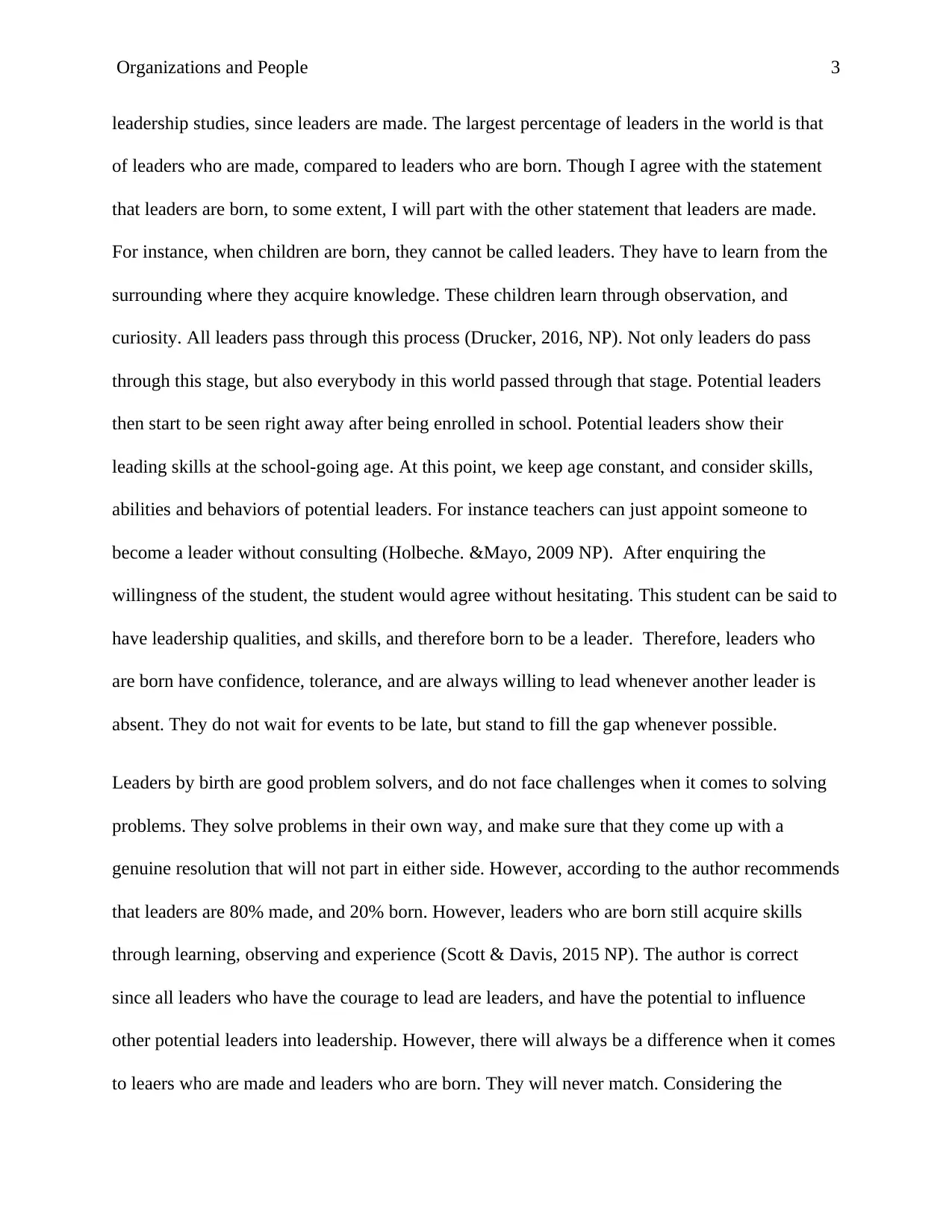
Organizations and People 3
leadership studies, since leaders are made. The largest percentage of leaders in the world is that
of leaders who are made, compared to leaders who are born. Though I agree with the statement
that leaders are born, to some extent, I will part with the other statement that leaders are made.
For instance, when children are born, they cannot be called leaders. They have to learn from the
surrounding where they acquire knowledge. These children learn through observation, and
curiosity. All leaders pass through this process (Drucker, 2016, NP). Not only leaders do pass
through this stage, but also everybody in this world passed through that stage. Potential leaders
then start to be seen right away after being enrolled in school. Potential leaders show their
leading skills at the school-going age. At this point, we keep age constant, and consider skills,
abilities and behaviors of potential leaders. For instance teachers can just appoint someone to
become a leader without consulting (Holbeche. &Mayo, 2009 NP). After enquiring the
willingness of the student, the student would agree without hesitating. This student can be said to
have leadership qualities, and skills, and therefore born to be a leader. Therefore, leaders who
are born have confidence, tolerance, and are always willing to lead whenever another leader is
absent. They do not wait for events to be late, but stand to fill the gap whenever possible.
Leaders by birth are good problem solvers, and do not face challenges when it comes to solving
problems. They solve problems in their own way, and make sure that they come up with a
genuine resolution that will not part in either side. However, according to the author recommends
that leaders are 80% made, and 20% born. However, leaders who are born still acquire skills
through learning, observing and experience (Scott & Davis, 2015 NP). The author is correct
since all leaders who have the courage to lead are leaders, and have the potential to influence
other potential leaders into leadership. However, there will always be a difference when it comes
to leaers who are made and leaders who are born. They will never match. Considering the
leadership studies, since leaders are made. The largest percentage of leaders in the world is that
of leaders who are made, compared to leaders who are born. Though I agree with the statement
that leaders are born, to some extent, I will part with the other statement that leaders are made.
For instance, when children are born, they cannot be called leaders. They have to learn from the
surrounding where they acquire knowledge. These children learn through observation, and
curiosity. All leaders pass through this process (Drucker, 2016, NP). Not only leaders do pass
through this stage, but also everybody in this world passed through that stage. Potential leaders
then start to be seen right away after being enrolled in school. Potential leaders show their
leading skills at the school-going age. At this point, we keep age constant, and consider skills,
abilities and behaviors of potential leaders. For instance teachers can just appoint someone to
become a leader without consulting (Holbeche. &Mayo, 2009 NP). After enquiring the
willingness of the student, the student would agree without hesitating. This student can be said to
have leadership qualities, and skills, and therefore born to be a leader. Therefore, leaders who
are born have confidence, tolerance, and are always willing to lead whenever another leader is
absent. They do not wait for events to be late, but stand to fill the gap whenever possible.
Leaders by birth are good problem solvers, and do not face challenges when it comes to solving
problems. They solve problems in their own way, and make sure that they come up with a
genuine resolution that will not part in either side. However, according to the author recommends
that leaders are 80% made, and 20% born. However, leaders who are born still acquire skills
through learning, observing and experience (Scott & Davis, 2015 NP). The author is correct
since all leaders who have the courage to lead are leaders, and have the potential to influence
other potential leaders into leadership. However, there will always be a difference when it comes
to leaers who are made and leaders who are born. They will never match. Considering the
⊘ This is a preview!⊘
Do you want full access?
Subscribe today to unlock all pages.

Trusted by 1+ million students worldwide
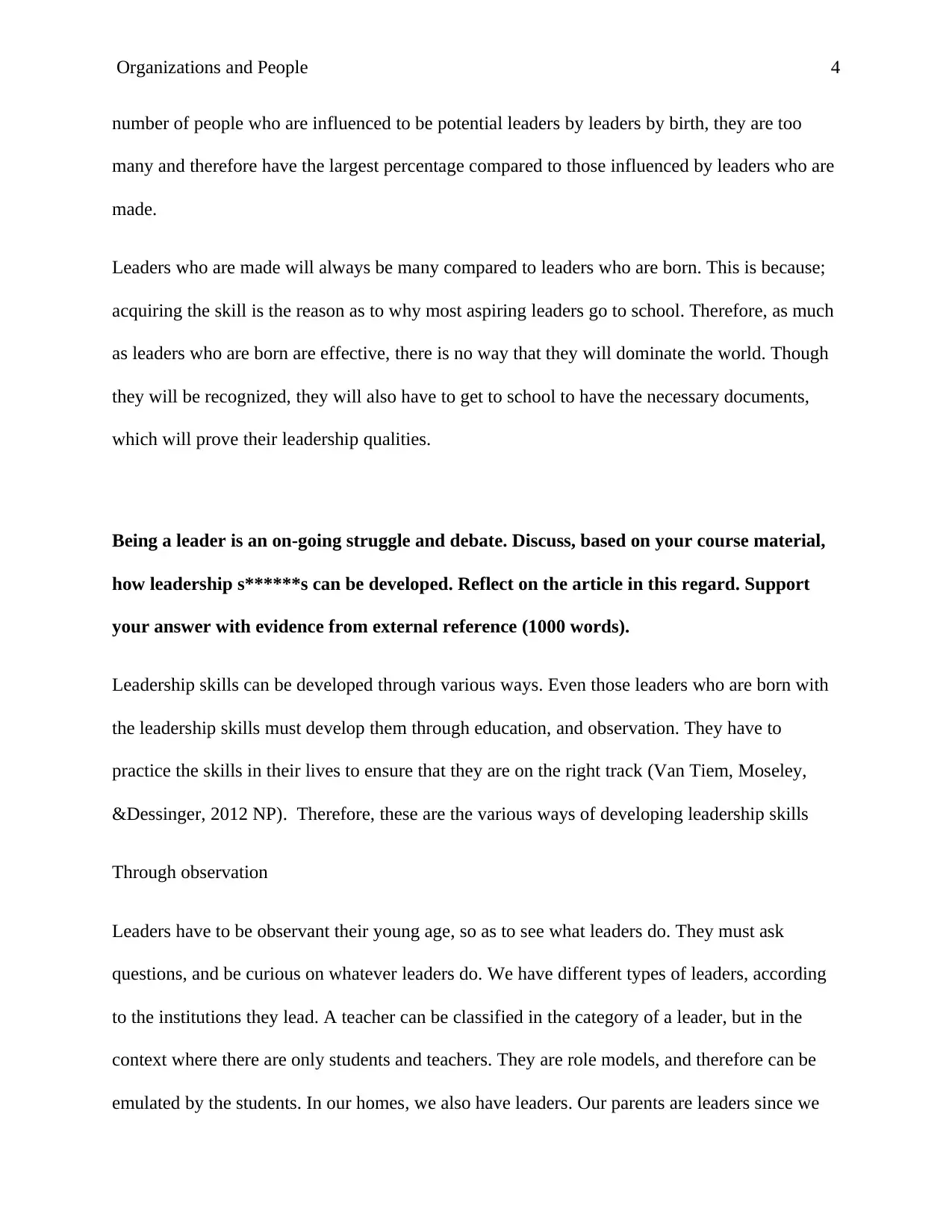
Organizations and People 4
number of people who are influenced to be potential leaders by leaders by birth, they are too
many and therefore have the largest percentage compared to those influenced by leaders who are
made.
Leaders who are made will always be many compared to leaders who are born. This is because;
acquiring the skill is the reason as to why most aspiring leaders go to school. Therefore, as much
as leaders who are born are effective, there is no way that they will dominate the world. Though
they will be recognized, they will also have to get to school to have the necessary documents,
which will prove their leadership qualities.
Being a leader is an on-going struggle and debate. Discuss, based on your course material,
how leadership s******s can be developed. Reflect on the article in this regard. Support
your answer with evidence from external reference (1000 words).
Leadership skills can be developed through various ways. Even those leaders who are born with
the leadership skills must develop them through education, and observation. They have to
practice the skills in their lives to ensure that they are on the right track (Van Tiem, Moseley,
&Dessinger, 2012 NP). Therefore, these are the various ways of developing leadership skills
Through observation
Leaders have to be observant their young age, so as to see what leaders do. They must ask
questions, and be curious on whatever leaders do. We have different types of leaders, according
to the institutions they lead. A teacher can be classified in the category of a leader, but in the
context where there are only students and teachers. They are role models, and therefore can be
emulated by the students. In our homes, we also have leaders. Our parents are leaders since we
number of people who are influenced to be potential leaders by leaders by birth, they are too
many and therefore have the largest percentage compared to those influenced by leaders who are
made.
Leaders who are made will always be many compared to leaders who are born. This is because;
acquiring the skill is the reason as to why most aspiring leaders go to school. Therefore, as much
as leaders who are born are effective, there is no way that they will dominate the world. Though
they will be recognized, they will also have to get to school to have the necessary documents,
which will prove their leadership qualities.
Being a leader is an on-going struggle and debate. Discuss, based on your course material,
how leadership s******s can be developed. Reflect on the article in this regard. Support
your answer with evidence from external reference (1000 words).
Leadership skills can be developed through various ways. Even those leaders who are born with
the leadership skills must develop them through education, and observation. They have to
practice the skills in their lives to ensure that they are on the right track (Van Tiem, Moseley,
&Dessinger, 2012 NP). Therefore, these are the various ways of developing leadership skills
Through observation
Leaders have to be observant their young age, so as to see what leaders do. They must ask
questions, and be curious on whatever leaders do. We have different types of leaders, according
to the institutions they lead. A teacher can be classified in the category of a leader, but in the
context where there are only students and teachers. They are role models, and therefore can be
emulated by the students. In our homes, we also have leaders. Our parents are leaders since we
Paraphrase This Document
Need a fresh take? Get an instant paraphrase of this document with our AI Paraphraser
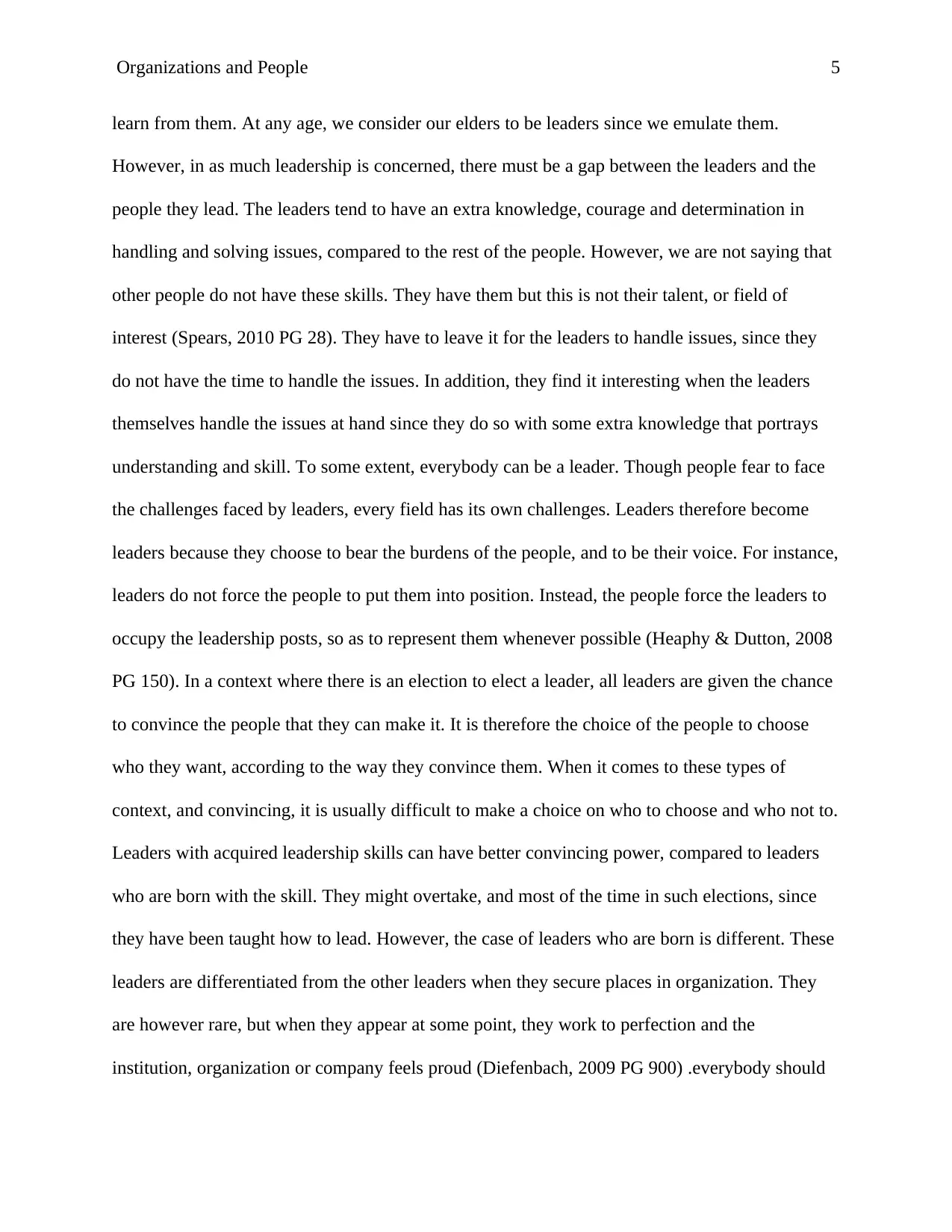
Organizations and People 5
learn from them. At any age, we consider our elders to be leaders since we emulate them.
However, in as much leadership is concerned, there must be a gap between the leaders and the
people they lead. The leaders tend to have an extra knowledge, courage and determination in
handling and solving issues, compared to the rest of the people. However, we are not saying that
other people do not have these skills. They have them but this is not their talent, or field of
interest (Spears, 2010 PG 28). They have to leave it for the leaders to handle issues, since they
do not have the time to handle the issues. In addition, they find it interesting when the leaders
themselves handle the issues at hand since they do so with some extra knowledge that portrays
understanding and skill. To some extent, everybody can be a leader. Though people fear to face
the challenges faced by leaders, every field has its own challenges. Leaders therefore become
leaders because they choose to bear the burdens of the people, and to be their voice. For instance,
leaders do not force the people to put them into position. Instead, the people force the leaders to
occupy the leadership posts, so as to represent them whenever possible (Heaphy & Dutton, 2008
PG 150). In a context where there is an election to elect a leader, all leaders are given the chance
to convince the people that they can make it. It is therefore the choice of the people to choose
who they want, according to the way they convince them. When it comes to these types of
context, and convincing, it is usually difficult to make a choice on who to choose and who not to.
Leaders with acquired leadership skills can have better convincing power, compared to leaders
who are born with the skill. They might overtake, and most of the time in such elections, since
they have been taught how to lead. However, the case of leaders who are born is different. These
leaders are differentiated from the other leaders when they secure places in organization. They
are however rare, but when they appear at some point, they work to perfection and the
institution, organization or company feels proud (Diefenbach, 2009 PG 900) .everybody should
learn from them. At any age, we consider our elders to be leaders since we emulate them.
However, in as much leadership is concerned, there must be a gap between the leaders and the
people they lead. The leaders tend to have an extra knowledge, courage and determination in
handling and solving issues, compared to the rest of the people. However, we are not saying that
other people do not have these skills. They have them but this is not their talent, or field of
interest (Spears, 2010 PG 28). They have to leave it for the leaders to handle issues, since they
do not have the time to handle the issues. In addition, they find it interesting when the leaders
themselves handle the issues at hand since they do so with some extra knowledge that portrays
understanding and skill. To some extent, everybody can be a leader. Though people fear to face
the challenges faced by leaders, every field has its own challenges. Leaders therefore become
leaders because they choose to bear the burdens of the people, and to be their voice. For instance,
leaders do not force the people to put them into position. Instead, the people force the leaders to
occupy the leadership posts, so as to represent them whenever possible (Heaphy & Dutton, 2008
PG 150). In a context where there is an election to elect a leader, all leaders are given the chance
to convince the people that they can make it. It is therefore the choice of the people to choose
who they want, according to the way they convince them. When it comes to these types of
context, and convincing, it is usually difficult to make a choice on who to choose and who not to.
Leaders with acquired leadership skills can have better convincing power, compared to leaders
who are born with the skill. They might overtake, and most of the time in such elections, since
they have been taught how to lead. However, the case of leaders who are born is different. These
leaders are differentiated from the other leaders when they secure places in organization. They
are however rare, but when they appear at some point, they work to perfection and the
institution, organization or company feels proud (Diefenbach, 2009 PG 900) .everybody should
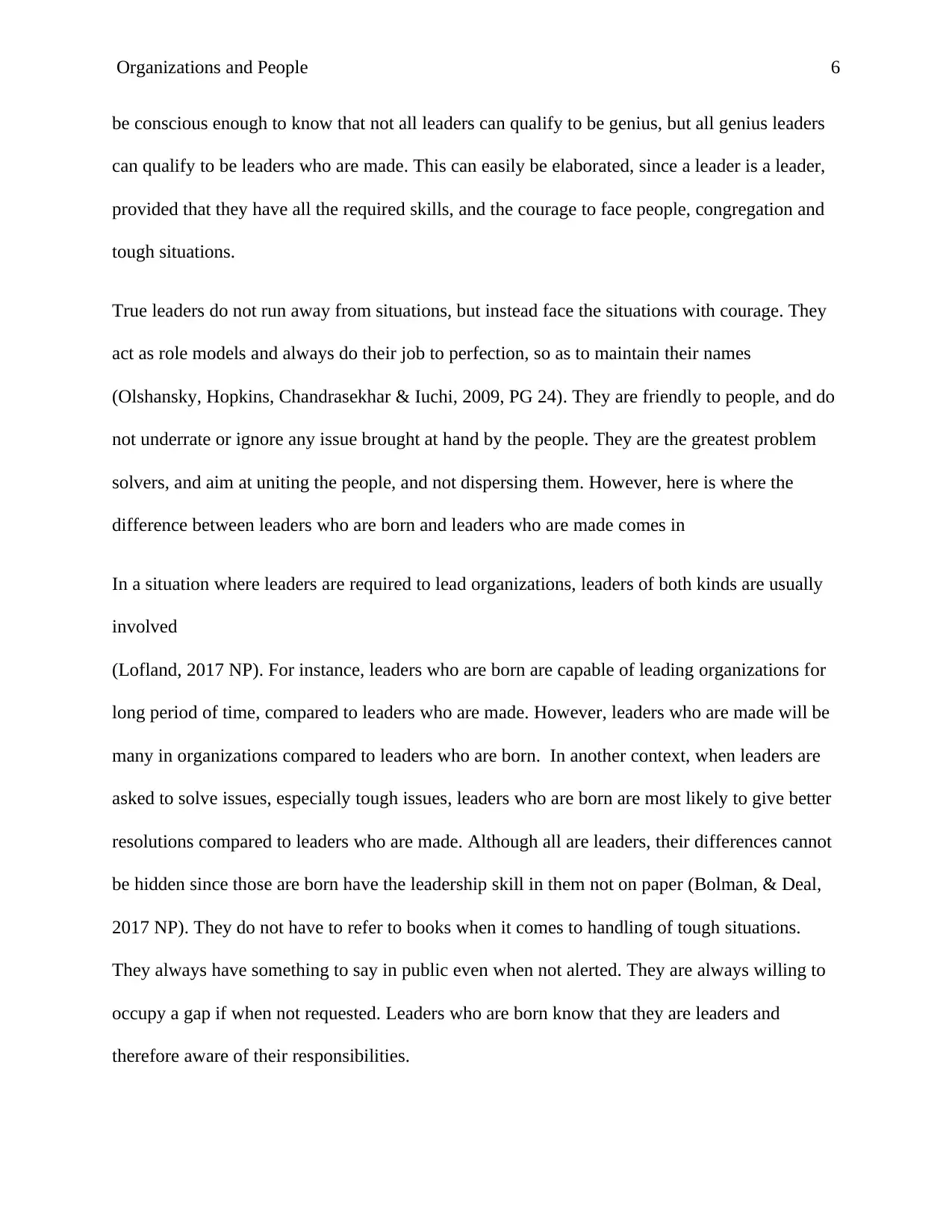
Organizations and People 6
be conscious enough to know that not all leaders can qualify to be genius, but all genius leaders
can qualify to be leaders who are made. This can easily be elaborated, since a leader is a leader,
provided that they have all the required skills, and the courage to face people, congregation and
tough situations.
True leaders do not run away from situations, but instead face the situations with courage. They
act as role models and always do their job to perfection, so as to maintain their names
(Olshansky, Hopkins, Chandrasekhar & Iuchi, 2009, PG 24). They are friendly to people, and do
not underrate or ignore any issue brought at hand by the people. They are the greatest problem
solvers, and aim at uniting the people, and not dispersing them. However, here is where the
difference between leaders who are born and leaders who are made comes in
In a situation where leaders are required to lead organizations, leaders of both kinds are usually
involved
(Lofland, 2017 NP). For instance, leaders who are born are capable of leading organizations for
long period of time, compared to leaders who are made. However, leaders who are made will be
many in organizations compared to leaders who are born. In another context, when leaders are
asked to solve issues, especially tough issues, leaders who are born are most likely to give better
resolutions compared to leaders who are made. Although all are leaders, their differences cannot
be hidden since those are born have the leadership skill in them not on paper (Bolman, & Deal,
2017 NP). They do not have to refer to books when it comes to handling of tough situations.
They always have something to say in public even when not alerted. They are always willing to
occupy a gap if when not requested. Leaders who are born know that they are leaders and
therefore aware of their responsibilities.
be conscious enough to know that not all leaders can qualify to be genius, but all genius leaders
can qualify to be leaders who are made. This can easily be elaborated, since a leader is a leader,
provided that they have all the required skills, and the courage to face people, congregation and
tough situations.
True leaders do not run away from situations, but instead face the situations with courage. They
act as role models and always do their job to perfection, so as to maintain their names
(Olshansky, Hopkins, Chandrasekhar & Iuchi, 2009, PG 24). They are friendly to people, and do
not underrate or ignore any issue brought at hand by the people. They are the greatest problem
solvers, and aim at uniting the people, and not dispersing them. However, here is where the
difference between leaders who are born and leaders who are made comes in
In a situation where leaders are required to lead organizations, leaders of both kinds are usually
involved
(Lofland, 2017 NP). For instance, leaders who are born are capable of leading organizations for
long period of time, compared to leaders who are made. However, leaders who are made will be
many in organizations compared to leaders who are born. In another context, when leaders are
asked to solve issues, especially tough issues, leaders who are born are most likely to give better
resolutions compared to leaders who are made. Although all are leaders, their differences cannot
be hidden since those are born have the leadership skill in them not on paper (Bolman, & Deal,
2017 NP). They do not have to refer to books when it comes to handling of tough situations.
They always have something to say in public even when not alerted. They are always willing to
occupy a gap if when not requested. Leaders who are born know that they are leaders and
therefore aware of their responsibilities.
⊘ This is a preview!⊘
Do you want full access?
Subscribe today to unlock all pages.

Trusted by 1+ million students worldwide
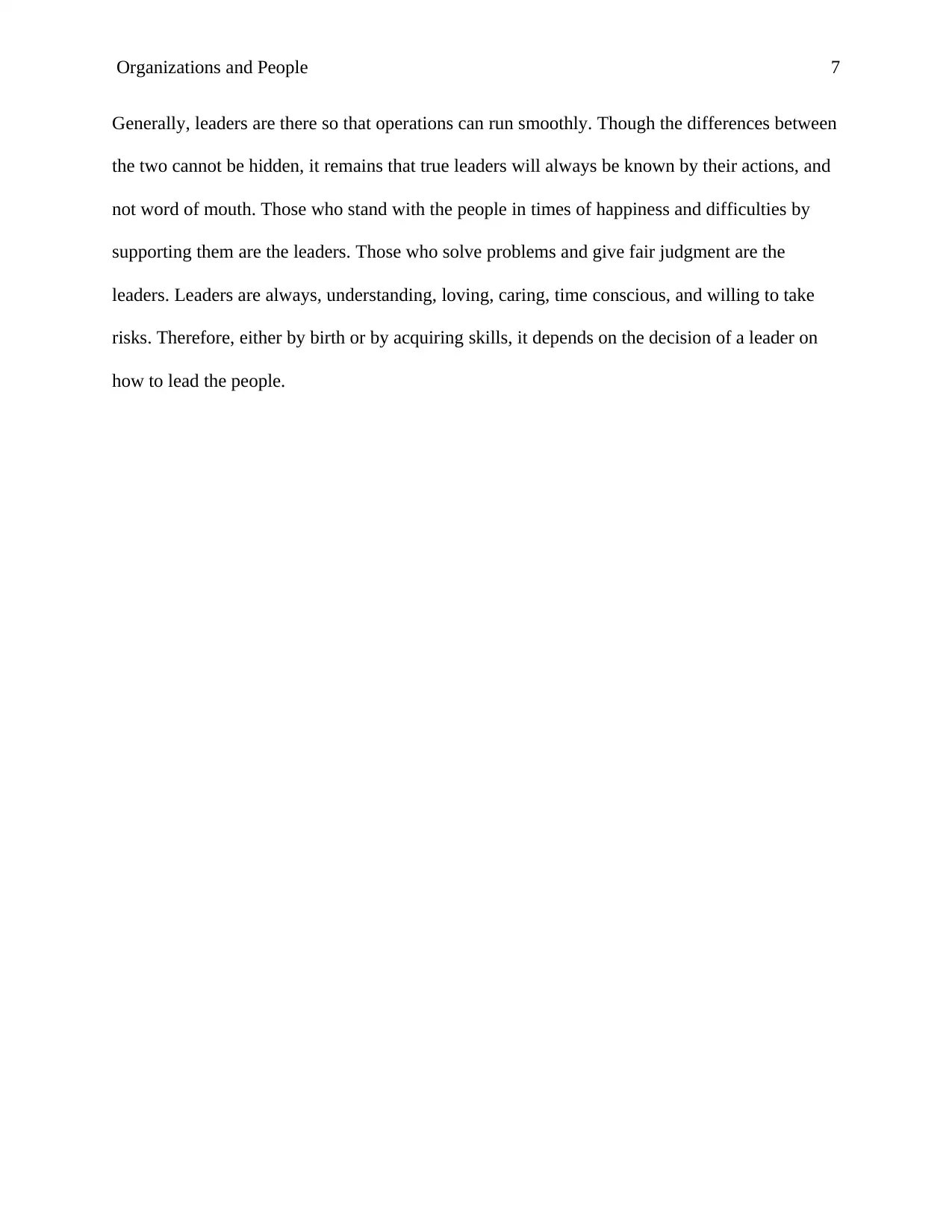
Organizations and People 7
Generally, leaders are there so that operations can run smoothly. Though the differences between
the two cannot be hidden, it remains that true leaders will always be known by their actions, and
not word of mouth. Those who stand with the people in times of happiness and difficulties by
supporting them are the leaders. Those who solve problems and give fair judgment are the
leaders. Leaders are always, understanding, loving, caring, time conscious, and willing to take
risks. Therefore, either by birth or by acquiring skills, it depends on the decision of a leader on
how to lead the people.
Generally, leaders are there so that operations can run smoothly. Though the differences between
the two cannot be hidden, it remains that true leaders will always be known by their actions, and
not word of mouth. Those who stand with the people in times of happiness and difficulties by
supporting them are the leaders. Those who solve problems and give fair judgment are the
leaders. Leaders are always, understanding, loving, caring, time conscious, and willing to take
risks. Therefore, either by birth or by acquiring skills, it depends on the decision of a leader on
how to lead the people.
Paraphrase This Document
Need a fresh take? Get an instant paraphrase of this document with our AI Paraphraser
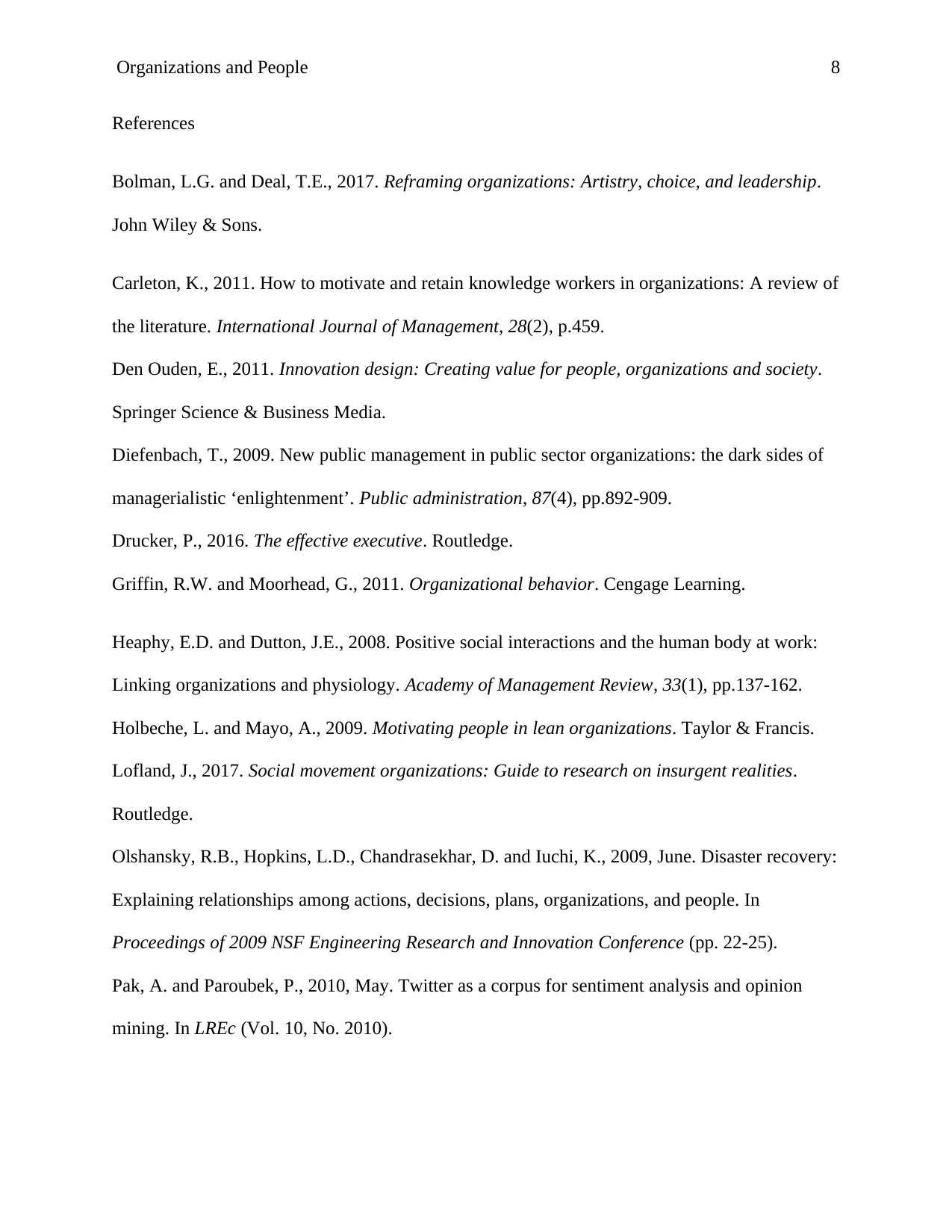
Organizations and People 8
References
Bolman, L.G. and Deal, T.E., 2017. Reframing organizations: Artistry, choice, and leadership.
John Wiley & Sons.
Carleton, K., 2011. How to motivate and retain knowledge workers in organizations: A review of
the literature. International Journal of Management, 28(2), p.459.
Den Ouden, E., 2011. Innovation design: Creating value for people, organizations and society.
Springer Science & Business Media.
Diefenbach, T., 2009. New public management in public sector organizations: the dark sides of
managerialistic ‘enlightenment’. Public administration, 87(4), pp.892-909.
Drucker, P., 2016. The effective executive. Routledge.
Griffin, R.W. and Moorhead, G., 2011. Organizational behavior. Cengage Learning.
Heaphy, E.D. and Dutton, J.E., 2008. Positive social interactions and the human body at work:
Linking organizations and physiology. Academy of Management Review, 33(1), pp.137-162.
Holbeche, L. and Mayo, A., 2009. Motivating people in lean organizations. Taylor & Francis.
Lofland, J., 2017. Social movement organizations: Guide to research on insurgent realities.
Routledge.
Olshansky, R.B., Hopkins, L.D., Chandrasekhar, D. and Iuchi, K., 2009, June. Disaster recovery:
Explaining relationships among actions, decisions, plans, organizations, and people. In
Proceedings of 2009 NSF Engineering Research and Innovation Conference (pp. 22-25).
Pak, A. and Paroubek, P., 2010, May. Twitter as a corpus for sentiment analysis and opinion
mining. In LREc (Vol. 10, No. 2010).
References
Bolman, L.G. and Deal, T.E., 2017. Reframing organizations: Artistry, choice, and leadership.
John Wiley & Sons.
Carleton, K., 2011. How to motivate and retain knowledge workers in organizations: A review of
the literature. International Journal of Management, 28(2), p.459.
Den Ouden, E., 2011. Innovation design: Creating value for people, organizations and society.
Springer Science & Business Media.
Diefenbach, T., 2009. New public management in public sector organizations: the dark sides of
managerialistic ‘enlightenment’. Public administration, 87(4), pp.892-909.
Drucker, P., 2016. The effective executive. Routledge.
Griffin, R.W. and Moorhead, G., 2011. Organizational behavior. Cengage Learning.
Heaphy, E.D. and Dutton, J.E., 2008. Positive social interactions and the human body at work:
Linking organizations and physiology. Academy of Management Review, 33(1), pp.137-162.
Holbeche, L. and Mayo, A., 2009. Motivating people in lean organizations. Taylor & Francis.
Lofland, J., 2017. Social movement organizations: Guide to research on insurgent realities.
Routledge.
Olshansky, R.B., Hopkins, L.D., Chandrasekhar, D. and Iuchi, K., 2009, June. Disaster recovery:
Explaining relationships among actions, decisions, plans, organizations, and people. In
Proceedings of 2009 NSF Engineering Research and Innovation Conference (pp. 22-25).
Pak, A. and Paroubek, P., 2010, May. Twitter as a corpus for sentiment analysis and opinion
mining. In LREc (Vol. 10, No. 2010).
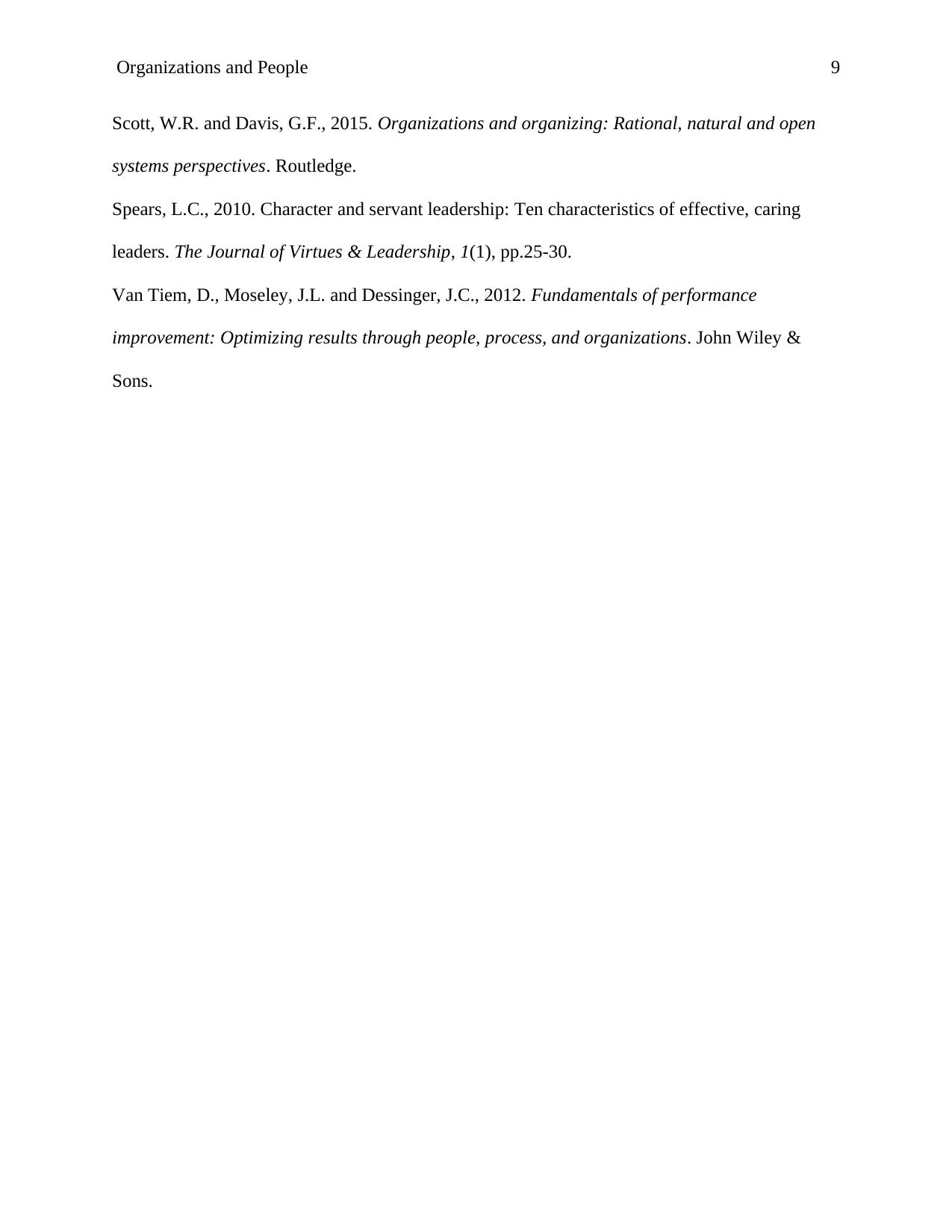
Organizations and People 9
Scott, W.R. and Davis, G.F., 2015. Organizations and organizing: Rational, natural and open
systems perspectives. Routledge.
Spears, L.C., 2010. Character and servant leadership: Ten characteristics of effective, caring
leaders. The Journal of Virtues & Leadership, 1(1), pp.25-30.
Van Tiem, D., Moseley, J.L. and Dessinger, J.C., 2012. Fundamentals of performance
improvement: Optimizing results through people, process, and organizations. John Wiley &
Sons.
Scott, W.R. and Davis, G.F., 2015. Organizations and organizing: Rational, natural and open
systems perspectives. Routledge.
Spears, L.C., 2010. Character and servant leadership: Ten characteristics of effective, caring
leaders. The Journal of Virtues & Leadership, 1(1), pp.25-30.
Van Tiem, D., Moseley, J.L. and Dessinger, J.C., 2012. Fundamentals of performance
improvement: Optimizing results through people, process, and organizations. John Wiley &
Sons.
⊘ This is a preview!⊘
Do you want full access?
Subscribe today to unlock all pages.

Trusted by 1+ million students worldwide
1 out of 9
Related Documents
Your All-in-One AI-Powered Toolkit for Academic Success.
+13062052269
info@desklib.com
Available 24*7 on WhatsApp / Email
![[object Object]](/_next/static/media/star-bottom.7253800d.svg)
Unlock your academic potential
Copyright © 2020–2025 A2Z Services. All Rights Reserved. Developed and managed by ZUCOL.





